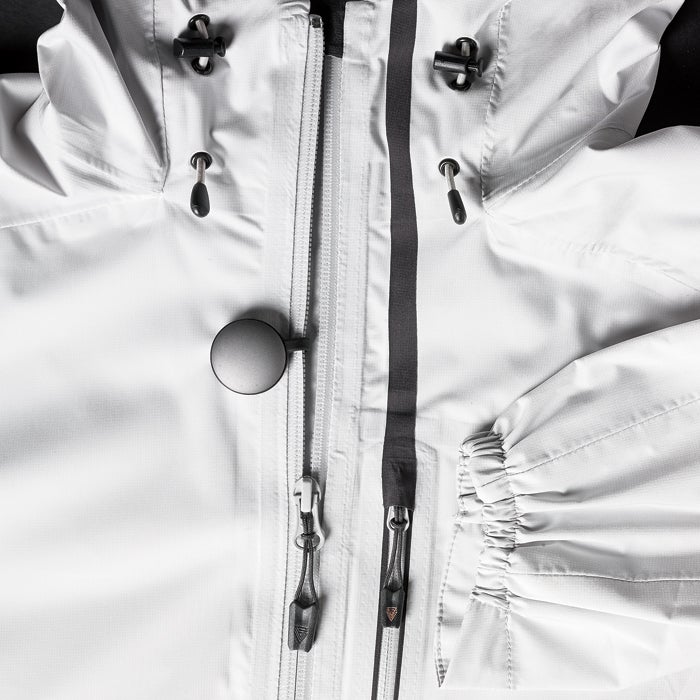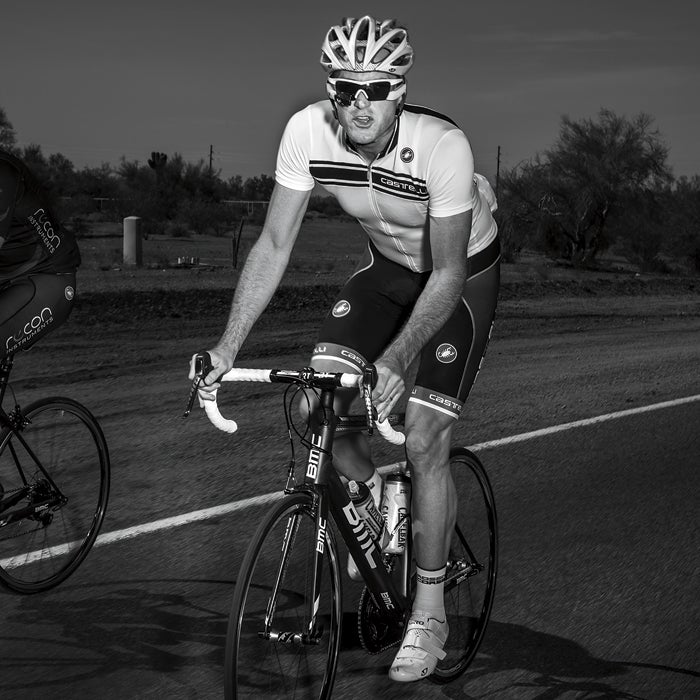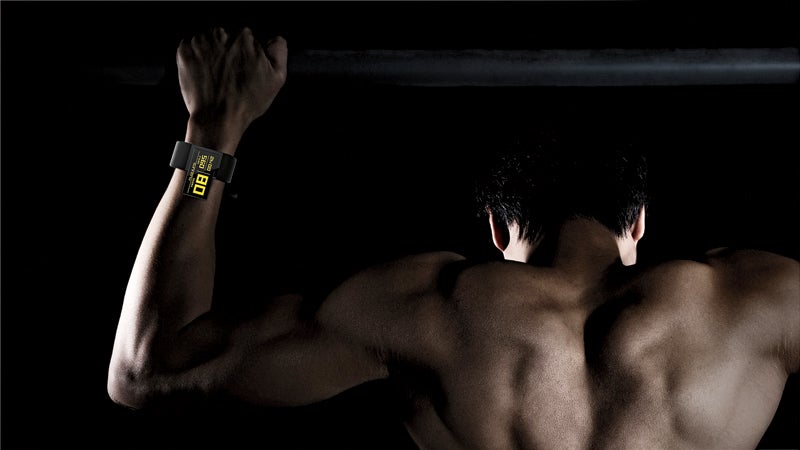Buzzing along in a feisty double pace-line on a on a crisp morning in Scottsdale, Arizona, the hump of Superstition Mountain looming on the horizon, the moment seemed right. I raised my finger to my sunglasses, gave a delicate swipe across the optical touch sensor, and began filming. Reviewing the footage later that evening, I witnessed one of the least epic cycling videos ever made: about seven seconds of the shadow of my passing finger, then my view repeatedly jerking over to Tyson Miller, the product director for Recon Instruments, riding on a neighboring bike, my wind-buffeted voice fretting, “Is this thing on?”
I was trying out the new Recon Jet, billed as —an inexact analogy would be a less expensive Google Glass, purpose-built for cycling. The device has long been a source of feverish speculation among data-minded time-trialers and triathletes, a heat-seeking missile aimed at the hearts of fitness geeks, and I was the first journalist to take it for a spin. Over dinner the night before my ride, Miller had whet my appetite by sketching out what the Jet will be able to do. The shades will automatically record a 15-second video clip when a rider hits a certain speed. When you arrive at the summit of a monster climb, the device will snap a photo and upload it to Instagram. Then there’s the text capability—messages sent to a user’s phone will be routed to the HUD. I had envisioned critical readouts of my body’s performance twitching like EKGs across a ghostly data field, a digital invisible hand pushing me toward the Top 10 on a Strava segment, man and machine becoming one, a skin-suited cycloborg.
But once we got out on the road, things were still pretty beta, and the view through my glasses was not so rose colored. The frames were 3-D-printed resin prototypes, so fit and comfort were approximate; the device also felt a touch heavy and kept sliding down my sweaty nose. (The finished product, which will be available to consumers in late spring, will weigh 60 grams, about twice as much as cycling-specific shades like the .) The small screen, which sits below and to the right of the user’s eyes, kept drifting out of position; the piercing head-on desert sun was washing out the resolution, making it harder for me to register whether I was filming or taking photographs. Then there was what I’ll call the Segway factor: the feeling that I couldn’t quite decide whether what I was doing was incredibly cool or inescapably dorky.
I kept glancing down and to the right, at a tidy little square where the data should have been—“like a car dashboard,” Miller said. But my dashboard was a static prototype, with placeholder fields for speed and cadence. And the Jet was not yet equipped for navigation or getting calls or showing watts. The future was right here, resting on the bridge of my nose, but somehow, like Superstition Mountain, it seemed just out of reach, a persistent mirage of great potential.
Wearable tech is everywhere—more than one wag has dubbed this the year of wearable computing—even if more people know about it than know what to do with it. Fitness nerds were an easy sell and have already embraced the stuff. (As a measure of market penetration, try syncing your heart-rate monitor to your Garmin at a race start amid the chorus of devices.) And as products become smaller and more powerful, there seems to be only one direction for the market to go. Fitness-tracking wristbands are already a $2.5 billion industry, although the kinks are still being ironed out, as evidenced by Fitbit’s , due to complaints about skin rashes. Oakley is of athletic apparel, including shorts and running shoes. The research firm IHS —from fitness trackers for suburban dog walkers to insoles that will tell runners if they’re overpronating—will hit more than 180 million units by 2017. That’s a drastic jump from the 20 million sold in 2010. But will the wearable-tech revolution lead to a new generation of plugged-in peak performers, or just enable more outlets for attention-fractured social-media narcissists?

I felt implicated in that very question. When not trying to break some personal record on a Strava cycling segment, I’d often find myself pausing to upload a shot of a gorgeous coastal California running trail to my snowbound Instagram friends back east. Wouldn’t it be great to fuse all this into a single, almost prosthetic device? Or would that only push me further away from the essence of pure athletic experience? There seemed to be no better device to test than Recon’s Jet. Not only is it the first cycling-specific unit, but Recon has long been at the forefront of wearable technology.
The company’s roots trace back to a 1996 Danish swim meet. There, 21-year-old aspiring professional swimmer lost by 0.28 second at a qualifying event for the national team. Eisenhardt was haunted by the number—he couldn’t stop wondering whether knowing his time during the swim might have compelled him to put in the effort required to win, setting his life on a different course. And so, in the mid-2000s, along with some fellow engineering students at the University of British Columbia, he set out to create swim goggles that would display real-time data.
In the end, ski goggles were a better fit for the company Eisenhardt cofounded, which became Recon in 2008. (Eisenhardt decided that the market for high-end wearable tech in the pool was simply too small.) In 2009, Recon began selling its Snow, Oakley and Smith could embed in their ski goggles. Curiously, as the company went through iterations of its operating system, Recon’s brain trust began to realize that customers were not always so interested in knowing hardcore performance data like the height and time of their jumps. “People were more interested in getting a text message on the mountain and keeping track of their kids,” says Miller. They veered toward games like Angry Birds, “to play on the lift ride up,” he notes. Recon has shipped some 50,000 units of the Snow, but ski-industry insiders consider the device more a high-cost piece of flair than a performance tool.
Recon hopes to change that with the Jet, its first soup-to-nuts wearable, which will target a much more data-obsessed community. As Dutch cyclist told me, “Some pros really are hooked to their screens. They literally look at their power every three seconds.” Not having to shoot those glances down at the handlebars could be less distracting than seeing something at the periphery of your vision. And, as Ten Dam notes, in a time trial, “it would be good to stay more aero, looking straight ahead rather than down at your power meter.”
According to Eisenhardt, the Jet isn’t just for pros. “The quantified-self movement extends way beyond the fanatics,” he says. “We all want to measure ourselves and compare ourselves to others, and we don’t want to reach into our pockets for our phones, because it disrupts our experience and frankly is unsafe.”
But HUD units have their own risks: People may end up paying more attention to the information in front of them than what’s actually in front of them. When I asked the cognitive scientist —coauthor of The Invisible Gorilla, a book that explores how intuition can deceive—about Google’s Glass and Recon’s Jet, in which information is relegated to the periphery of the visual field, he told me that visual distraction may be less important than cognitive distraction. “I don’t think the thing being there is typically the problem,” Simons says. “It’s the attention load. How often are you going to look at your speed? Whereas if your Facebook stream is there and it’s perpetually changing and interesting, you might not be aware of how much attention you’re paying to it.”
I actually found the Jet to be less distracting than I had anticipated. The display was not as immersive as a smartphone. The screen was never in front of my eyes; it required a conscious glance to the lower-right corner—arguably a better placement for a cyclist than, say, Google Glass’s eyebrow orientation. Recon also has a forthcoming gaze-detection system that will blank the screen when the user isn’t looking at it, to save battery life.
Distraction, of course, is cognitive, not just physical—a text informing you that your house is being broken into will consume more of your attention than your current speed. But a discussion about potential distraction should factor in what cyclists are already doing: glancing down at a Garmin, fumbling in a jersey pocket for a phone. The Jet, Eisenhardt points out, could mitigate these risks.
Recon is certainly breaking new legal ground, as the Jet will presumably be used mostly on public roads. It’s currently illegal to drive in the state of New Jersey while using Google Glass. Will it be illegal to cycle while wearing a HUD? Legislation has yet to tackle that, but the point crossed my mind during our ride on the Apache Trail, when our group of three was pulled over by an Arizona Department of Public Safety trooper. A self-identified cyclist, he angrily accused us of blocking traffic on the narrow road. The Jet is pretty unobtrusive, and until then no one—not even another cyclist—had asked about it. Still, as we politely resolved the situation, I half expected the trooper to call attention to my shades. He never did, but I was prepared. If things turned nasty, I thought, I could discreetly start filming.

The biggest performance boon, however, would come from using data in real time. Miller lays out the scenario: You’re going for a ride, and while you’re on a Strava segment the Jet gives you time and ranking updates. When you’re finished, it tells you how you did. It’s not available yet, because it would involve integration with Strava’s proprietary software, but the companies are talking.
How desirable this virtual video game actually is probably depends on your relationship with technology and riding. The Jet could serve as a surrogate coach when you’re out on a solo training effort, or it could just put another data layer between you and your group ride. Having not yet tested the fully realized product, I’m on the fence. There might be some virtue in not having to look down at my handlebars all the time. But the bike is one of the few places I feel free to completely disengage. I’ll read your text messages later.
Still, riders like myself who have some reservations about the cycloborg scenario may just need to get past them. Eisenhardt says Recon’s technology “is relevant for any activity where you are in motion but depend on frequent information to enhance your performance.” That’s a pretty broad swath, and the company routinely fields a wide range of inquiries: from sailors, hunters, motocross riders. The wingsuit pilot Jeb Corliss was , a version of its ski goggles that displays things like forward speed and glide ratio.
Corliss, in a promotional video, speaks of a longstanding wish, once fanciful, now emergent, to “have instrumentation like any pilot.” Fighter pilots, he says, “don’t have to fly on feel. They actually know” what they’re doing. An increasing body of research reinforces how important that can be. A study in the Journal of Orthopedic Sports and Physical Therapy , runners could reduce “lower extremity loading”—literally changing the way they run. In another study, in the journal Sports Technology, after getting audio feedback on lateral displacement via a sensor. Ubiquitous, accessible data only draws the feedback loop tighter. With that meta-awareness, says Corliss, athletes can “actually get better at what we’re doing.”
And so can you. Just not quite yet.


